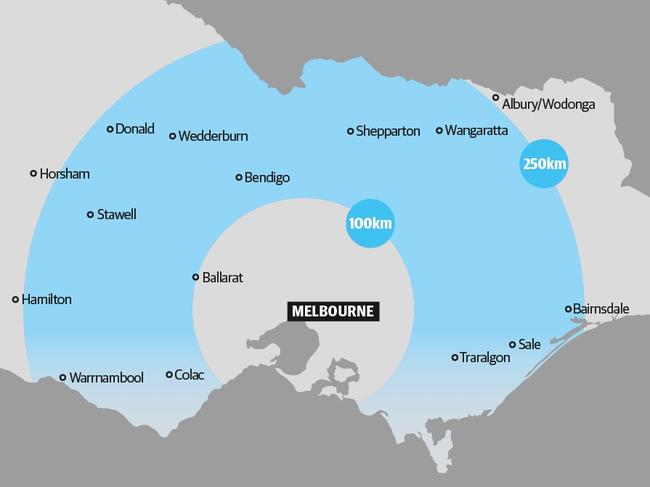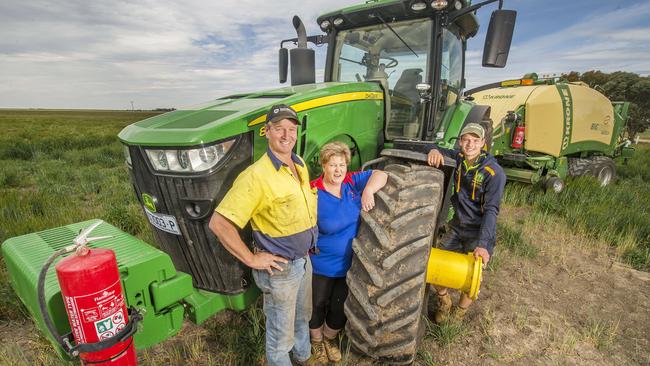Satellite cities planned around Melbourne to ease population crush
New satellite cities of up to 400,000 people would be built within two hours of Melbourne’s CBD under a radical plan to tackle population growth. But where?
Future Victoria
Don't miss out on the headlines from Future Victoria. Followed categories will be added to My News.
Victoria needs to build a series of new cities housing up to 400,000 people each to offset Melbourne’s population crush.
The ring of cities — 100-250km from the CBD — would be built from scratch on greenfield sites instead of expanding existing regional centres like Geelong, Ballarat and Bendigo.
The ambitious 20-year proposal, outlined in a plan from experts at three of Victoria’s top universities, would zero in on locations with existing rail infrastructure that could eventually be upgraded to run high-speed trains.
Around six new cities, which would each have a population of at least 100,000 people, could be eventually be filled over the two decades based on Melbourne’s population growth.

RMIT University deputy pro vice-chancellor Ralph Horne, a co-author of the plan, told the Herald Sun the satellite cities would draw residents away from Melbourne.
“Victorians will be attracted to them because they will offer new employment opportunities, new housing opportunities, and different sorts of living arrangements — as well as being hyperconnected to Melbourne,’’ he said.
Experts from RMIT, Monash University and the University of Melbourne have developed the new cities plan for public policy organisation Balance Victoria.
Former Labor premier Steve Bracks and ex Nationals deputy premier Pat McNamara last year used the platform to also back a decentralisation strategy.
“There is a common presumption that decentralisation in Victoria has failed due to a plethora of policy proposals that have never been followed through,” Prof Horne said.
“But that’s not true, decentralisation has never been given a chance to succeed. It’s always looked at in isolation.
“It needs to be integrated into a wider long-term network of policies on affordable housing, accessible transport, high-speed rail, and long-range economic planning to be successful.”
The report’s authors — who also include Lauren Piko and Elizabeth Taylor — note while Canberra is often subject to good-natured ribbing it’s a successful template for a greenfield city built from scratch.
They argue expanding cities comes with inherited inefficiencies in areas such as how transport is planned out.
“Given the time frame over which Victoria’s population is growing, and current building rates, it is prudent to plan for 20-year time frames to establish sustainable new centres,” the report said.
“This would allow for new cities of 100-400,000 people (40-150,000 dwellings) to be built, removing much of the congestion pressure from Melbourne, while also encouraging new industries to locate there.”
MORE FUTURE VICTORIA NEWS:
WHAT’S IN STORE FOR VICTORIA’S FUTURE?
CYBER EDUCATION KEY TO FIGHTING SCAMS
The experts also point to Milton Keynes in the UK as an example of a built-for-purpose city.
It was devised to relieve pressure from Greater London and is now among the top five fastest growing centres in the UK and a key economic hub.

Prof Horne said it was too early to identify which greenfield locations would best suit new Victorian cities or how many should be built.
Balance Victoria envisages the new cities would be self-sufficient in water and energy, ultra-low carbon emitters.
They would be designed to be car-free as much as possible, walkable and denser than existing towns but with a focus on public open space.
“It is often cheaper and more eco-friendly to build new with eco-technology and design than it is to reconstruct existing systems,” Prof Horne said.
“As new towns they will have a different character and will therefore not so much compete with existing towns and settlements, but add diversity and opportunity.
“The extent to which existing regional centres want to be attached to, or near, these cities should be subject to more detailed investigation and of course consultation. Do those living in Bendigo or Ballarat want to double their city and change its character in the process?”
Solid commitments from the state and federal governments is needed for the plan to get the go ahead, according to the report.
SATELLITE CITIES ARE ON THE RADAR
It’s a place where the big smoke couldn’t seem further way — and that’s just how locals in Victoria’s Wimmera like it.
A grand plan to build satellite cities encircling Melbourne got a bemused reception in the tiny farming region of Minyip, just over 250km as the crow flies from Melbourne’s CBD.
Mother-of-four Loretta Leith said she thought decentralisation to smaller towns such as nearby Donald was a “fantastic idea”.
“We’ve got wonderful shops in Donald, we have a lot of small family businesses,’’ Ms Leith said.
“Having people from the city purchase our stuff and take ideas back to the city could bring a bit of country into the city.”
But Ms Leith would not welcome multi-storey buildings in Donald or Minyip.
“We’d have to cut down trees and in drought areas we can’t afford that,” she said.
“Donald is very family and community orientated. It’s such a small community. When someone is in trouble the community gets behind each other.”

A stone’s throw away in Rupanyup farmers Andrew and Julie Weidemann thought the satellite city idea had “merit”.
Ms Weidemann said decentralisation could bring more opportunities to the community.
“It would be good for people in the country to have similar services to the city — we struggle to get doctors and professional people out to small towns,” she said.
The couple said Rupanyup’s country atmosphere was a good place to raise a family and allowed them to expose son Jordan, 19, to a unique range of experiences.
With Brianna Travers and Rhiannon Down
